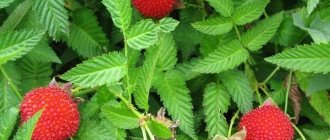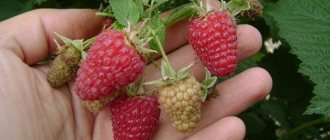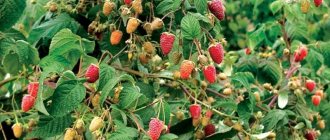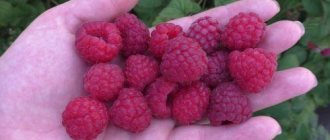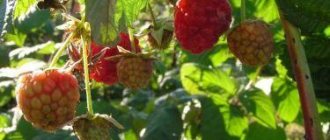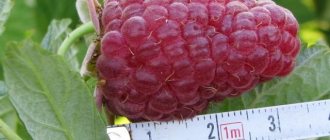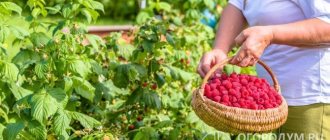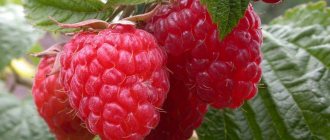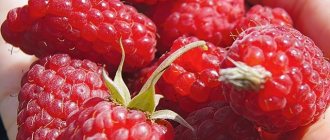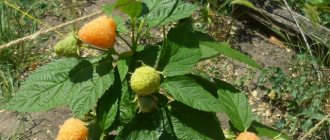Description of the raspberry variety Penguin
Raspberry Penguin belongs to the remontant varieties of early ripening. It is a bush with straight, standard-type shoots. The height of the Penguin raspberry stems, judging by the description, reaches 1.3-1.5 m, the number of which is limited to 4-6 pieces.
Annual shoots are green, with a significant waxy coating. Two-year-old shoots are light brown, strong, with short internodes. At each node a short but strong berry cluster is formed, on which 8-10 berries are placed. The shoots have short, slightly curved downward spines of crimson or green color. They are distributed unevenly along the stem, with more thorns at the bottom and fewer at the top.
The leaves are ordinary, green, slightly wrinkled, and have fibers. There are small teeth along the edges of the leaves. The side branches with ovaries are covered with a light waxy coating. The flowers are medium-sized and white. The berries are large, crimson, conical in shape with a rounded top. The average fruit weight is 4.2 g, maximum weight is 6.5 g.
It is preferable to cultivate the Penguin variety using one-year cultivation technology, that is, in the fall, all stems are cut and burned. Next year, a magnificent harvest of delicious raspberries will appear on the annual shoots. Autumn fruiting covers most of the stem. Berries begin to ripen in the southern regions in mid-July, in the northern regions - in early or mid-August. When grown in a two-year cycle, Penguin raspberries produce the first harvest in late spring, and the second in late summer. With this method of cultivation, the yield and size of the berries are reduced, and full ripening of the berries is possible only in the southern regions.
Description of the raspberry variety King Penguin
King Penguin raspberry is a tall variety of the remontant variety Penguin. The shoots of the plant are straight and grow up to 1.8 m in height. Thanks to the strength of the stems, the plant can withstand the load of the harvest without being tied to a support. The King Penguin variety produces little growth. This complicates the propagation of the crop, but simplifies the care of the raspberry tree, since the raspberries do not grow haphazardly throughout the garden.
According to gardeners, the berries of remontant King Penguin raspberries are distinguished by their round shape, large size, weight (8-10 g) and bright red color.
Description of the raspberry variety Yellow Penguin
Another variety of Penguin raspberries, but with yellow berries, is the Yellow Penguin variety. The plant is a standard type, compact, stems up to 1.5 m long. It forms only 3-4 strong shoots. The productive variety Yellow Penguin has large berries, weighing 7-8 g, dense, round in shape.
Yellow Penguin
Yellow Penguin is a yellow-fruited variant of the Penguin variety. The bushes are powerful, straight-growing, compact, low (no more than 1.0-1.5 m), and do not require trellises. During fruiting they look very decorative, like small trees covered with yellow fruits. The berries are round-conical, bright yellow, medium size (4-5 g), dense. The drupes are well adhered, the fruits do not wrinkle or fall apart when picked. The taste of the berries is sweet and sour, with a predominance of sourness. The transportability of yellow-fruited raspberries is quite low. Yellow Penguin stands out among other varieties due to its good indicators of both transportability and keeping quality. The ripening period is one of the earliest among remontant varieties. In the conditions of the Central part of Russia, the Yellow Penguin manages to produce the entire harvest before frost.
Characteristics of the variety
To choose a suitable variety for growing on your personal plot, it is worth taking into account the characteristics of raspberries. The main criteria for evaluating a particular variety are frost resistance, yield, resistance to adverse factors, and area of application.
Drought resistance, frost resistance
Raspberries of the Penguin variety are frost-resistant. In late autumn, raspberry stems are completely cut off at the root. This allows the variety to be grown in the northern regions. When grown for two years, the stems of the Penguin and Yellow Penguin varieties can withstand frosts down to - 25 ° C, and the Royal Penguin variety - up to - 33 ° C.
Productivity and fruiting
The average yield of the Penguin variety is 3.5 kg per bush. The fruits hold their shape well, withstand transportation over long distances, are not prone to shedding, and do not wither in the sun. Fruiting is extended (August-October), harvesting is carried out after 1-2 days. The taste of the berries is sweet and sour, without a pronounced aroma, with a sugar content of 3.1%. The tasting assessment of taste, determined by specialists, is 3.7 points.
The yield of the Royal Penguin variety in favorable conditions reaches 5-7 kg per plant. Fruiting continues from August to October. Ripe King Penguin berries are not prone to shedding and remain on the branches for up to 5 days. According to reviews from owners of the Royal Penguin raspberry variety, the taste of the berries is sweet and sour.
The average yield of the Yellow Penguin variety per plant is 5-6 kg. The variety is early ripening - the first harvest appears at the end of July. Ripe Yellow Penguin berries retain their shape during harvesting and transportation. When growing Yellow Penguin, even in the shade, the fruits have a dessert taste.
Area of application of fruits
Remontant raspberries of the Penguin variety are consumed both fresh and frozen. Or used to make preserves, jellies, jams, marmalade, juices and compotes. Dried fruits and leaves are used as a diaphoretic and antipyretic for colds and flu. The leaves are used as tea. Before this, they are fermented and dried. Infusions and decoctions are also used in folk medicine to treat various diseases.
Resistance to diseases and pests
The Penguin variety, when cultivated as an annual crop, is not attacked by pests and does not get sick. This is due to the fact that in the fall the shoots are cut off at the root and burned. Diseases and pests simply have nowhere to overwinter and reproduce.
Advantages and disadvantages of the variety
The Penguin variety has many advantages, which is why it is in demand in amateur gardening.
Advantages:
- high productivity;
- large fruit;
- decorativeness;
- high keeping quality of berries;
- frost resistance up to - 25 ° C;
- resistance to diseases and pests.
Flaws:
- thorns on shoots;
- mediocre taste;
- demands on soil and watering.
Reviews from gardeners
Marina, 31 years old, Voronezh
Three years ago we decided to completely renovate the raspberry garden at our summer cottage. We chose it based on the description of the variety, photos and reviews. King Penguin raspberries attracted high yields and resistance to diseases and pests. There are no thorns at the top of the shoots, which greatly simplifies harvesting. The taste of the berries is not bad, but there are sweeter varieties. The fruits are large and dense, the drupes are almost invisible. Ideal for recycling.
Mikhail, 57 years old, St. Petersburg
According to the description, photos and reviews, the Penguin raspberry variety is one of the favorites in my garden. The bushes are low and strong. The fruits ripen in the second half or at the end of August, depending on weather conditions. It is better to collect them immediately after ripening; if they hang for too long, they lose their presentation. The berry is beautifully shaped, not dry. There is a hint of sourness in the taste.
Tamara, 44 years old, Kuban
We grow raspberries for harvesting, some of the berries are sent for sale. They were looking for a variety with good commercial qualities that could withstand long transportation. We chose Penguin raspberries based on the description of the variety, reviews and photos. This is a remontant variety; in our climate, the first berries ripen in June. Fruiting lasts until autumn frosts. The berry of the Penguin variety is dense and large, it is easy to pick. The fruits do not wrinkle during transportation. The bush itself is very compact; it does not need support. The variety is suitable for decorating hedges.
Landing Features
The peculiarities of planting Penguin raspberries include its demands on soil composition and lighting. The variety is comfortable growing in soil with weak or neutral acidity. In soil with high acidity, fertilizers are ineffective. An indicator that the soil is acidic is the presence of plants such as horsetail, sorrel, woodlice, and bindweed in the area. You can deoxidize the soil by adding limestone or dolomite flour.
Before planting raspberries, it is recommended to sow green manure on the site and then embed it in the ground. Also, rotted manure and humus are added to the soil under the raspberry tree, combined with the application of potassium and phosphorus fertilizers. Such events will provide raspberries with food for 3-4 years.
Advice! No less important is the location of raspberry plantings in an area open to light, which will be warmed by the sun throughout the day.
In the sun, the berries ripen earlier and become sweeter.
Penguin raspberries are not suitable for areas where rainwater stagnates or where groundwater is located high. With excess water, raspberry roots are susceptible to rotting.
Recommended timing
Raspberries can be planted in spring and autumn. Autumn planting allows you to get a harvest the following year. Preparations for it should begin in the summer. The planting area should be dug up with fertilizers. Favorable time for planting is September-October. The cuttings will have time to root in order to produce young shoots as early as possible in the spring. This is important for remontant raspberries, since berries will set and ripen on these shoots. When planting in spring, the time for fruiting comes later, as the seedling needs time to adapt. But over the summer, the young plants will get stronger and survive the winter safely.
Choosing a suitable location
Experts recommend planting the remontant Penguin raspberry on the south side of residential buildings, fences, and outbuildings. The buildings protect the plantings from the northern winds. In these places, the snow melts earlier and the earth warms up faster. The sooner the snow melts from the plantings and the shoots begin to grow, the sooner the first berries will appear.
The Penguin variety does not like waterlogging. Raspberries are not placed in lowlands where moisture is retained. To drain water, drainage ditches should be dug around the perimeter of the planting.
Advice! Raspberries should not be planted after potatoes, tomatoes, or eggplants, as they share diseases with them.
Selection and preparation of planting material
It is safer to purchase raspberry seedlings in specialized stores and nurseries. You should choose high-quality specimens with well-developed roots and buds at the base of the shoots (at least 3).
Landing algorithm
Planting technology:
- Dig holes 45x50 cm in size and 40 cm deep, maintaining 70 cm between them, and 1.5-2 m between rows. The removed soil should be thoroughly mixed with fertilizer, after which half the volume should be placed at the bottom of the hole.
- Soak the seedlings in the biostimulator for 2-3 hours.
- Place each plant in a hole, straighten the roots, and cover with soil.
- Compact the soil and water generously.
- The seedling should be trimmed, leaving no more than 6 cm above the ground. Mulch around the plant with sawdust, straw or hay.
Specifics of cultivation
Growing remontant raspberries does not require additional knowledge; the main thing is to purchase healthy seedlings, choose a sunny area and prepare fertile soil.
Preparing the site and seedlings
When purchasing planting material, carefully inspect the rhizome and appearance of the plant for damage and disease.
For planting raspberries, choose dry, well-lit and draft-free land plots on small hills. In lowlands and swampy soil, the bushes do not take root, they begin to get sick, and as a result they die.
- The selected area is dug up, cleared of weeds, and the soil is loosened.
- The soil is mixed with humus, organic matter and minerals.
- 2-3 weeks before planting, holes are dug in the prepared area.
- The depth and width of the holes is 50 cm, the distance between plantings is 80 cm, between rows is from 1 to 1.5 m.
- I lay out a drainage layer at the bottom of the hole, pour fertile soil on top and water it.
- Before planting in open ground, seedlings are placed in a container with water for 5-8 hours, treated with antibacterial agents and a growth stimulator.
Important! If groundwater is close to the site, an additional embankment is made or the place where the berry crop is planted is moved.
Planting dates and scheme
The timing of planting raspberries in open ground depends on the climatic characteristics of the region.
In southern latitudes and regions with a temperate climate, bushes are planted in the fall, 4-6 weeks before the onset of the first frost.
In cold climates, planting work is planned for the spring.
- The seedling is placed in the prepared holes at a slight angle.
- The roots are evenly distributed over the hole and covered with fertile soil, trying not to leave voids between the roots and the soil.
- The soil under the seedling is compacted and watered with settled water.
- Plants are trimmed to a mark of 7 cm.
Advice! After planting the raspberries, the tree trunk circle is mulched with humus or dry grass.
Favorable and Undesirable Neighbors
To grow healthy and productive raspberries, you must follow the rules of crop rotation.
It is not recommended to plant berry bushes after potatoes, eggplants, plants from the nightshade family and tomatoes. Vegetable crops are often affected by the same diseases as raspberries, and the soil after them can be contaminated.
Onions, garlic, bulbous flowers, garden strawberries, and any plants from the legume family are planted next to raspberries. Soil enriched with vitamins and nutrients remains after planting cereals, beans and peas.
See also
The best raspberry varieties for the Moscow region with descriptions and characteristics
Read
Watering and fertilizing bushes
Water remontant Penguin raspberries as the soil dries out. With severe stagnation of moisture, the roots of the plant rot, and prolonged drought affects the yield and taste of the berries. An important point is the period of formation of ovaries and ripening of fruits. At this time, berry bushes require additional moisture.
Due to rapid fruiting, raspberries require additional fertilizers and fertilizing. At the beginning of spring and before flowering, the bushes are fed with mineral fertilizers. At the end of autumn, humus and cow or bird manure diluted with water are added to the soil.
Loosening and mulching the soil
Weeding and loosening of the soil are timed to coincide with irrigation activities. Loosening allows you to enrich the soil and plant roots with oxygen, and removing weeds reduces the risk of the spread of diseases and pests. If you mulch the soil, then reduce the amount of watering. Mulch helps retain soil moisture for a long time and prevents weeds from germinating.
Pruning and shaping the plant
In early spring, sanitary pruning of bushes is carried out, removing all broken, frozen, dried and damaged stems and shoots.
Autumn work on pruning raspberries is carried out after harvesting.
Depending on the chosen method of growing the berry crop and the region of growth, fruit-bearing branches are removed from the bushes, leaving only 10-12 cm of young shoots. In case of cold winters, all stems and shoots are removed at the root.
Shelter for the winter
With the onset of autumn, the raspberry tree is watered abundantly, the tree trunk circle is mulched with a thick layer of humus or peat mixed with sawdust.
The berry bush, pruned at the root, is covered with mulch or spruce branches, and after the first snow falls, snowdrifts are made. If the shoots are left for the winter, they are bent to the soil, carefully fixed and covered with spruce branches, burlap or special materials. When snow appears, high snowdrifts are raked over the bushes.
Seasonal treatment against insects and pests
Raspberry Penguin has strong immunity to diseases and pests. But, when unpruned shoots overwinter, the plant can be affected by fungi and pests. For prevention purposes, in early spring before the onset of the growing season, I treat the fruit crop with specially infused solutions or professional preparations.
Aftercare
Caring for raspberries affects the quality of the berries and involves watering and fertilizing.
Raspberries of the Penguin variety are intended for growing as an annual crop. This makes caring for raspberries easier. In October, all shoots are cut off at the root without stumps. In the spring, in order to encourage the sprouts to awaken, the area with raspberries must be cleared of snow and covered with film. The tops of young shoots do not need to be trimmed.
Raspberries need moderate systematic watering with settled water in the morning or evening. After moistening, the soil is loosened and weeds are removed. Mulching the soil around the bushes will help reduce the number of waterings and retain moisture in the ground.
Remontant raspberries of the Penguin variety require periodic feeding.
| Fertilizing time | Feeding method | Fertilizers/proportions per 1 sq. m |
| Early spring | Prikornevoy | Universal fertilizers containing nitrogen, potassium, phosphorus. Ammonium nitrate (15-20 g per 10 liters of water). An alternative is humus, bird droppings, urea. |
| Before flowering | Prikornevoy | Double superphosphate (3 tbsp) and potassium sulfate (2 tbsp) are dissolved in 10 liters of water. Infusions of nettle and ash. |
| Late autumn | Prikornevoy | Humus or compost. Adding wood ash. |
In order for remontant Penguin raspberries to survive the winter well, it is necessary to water the plantings abundantly before the first hard frost. If the shoots are cut at the root, then the roots should be covered with peat, humus or straw.
Annual shoots left to obtain a double harvest should be bent to the ground and covered. It is convenient to tie the stems to a wire stretched at a height of 35-40 cm from the ground. Then cover the bushes with covering material. In winter, you need to ensure that the raspberry tree is always covered with a layer of snow of at least 0.5 m. In winters with little snow, the raspberry tree is covered with snow manually.
Harvesting and processing
Picking Penguin raspberries is a real pleasure. Firstly, bushes with ripe berries look very beautiful. Secondly, you don’t need to look inside each berry, and then also soak it in salt water to get rid of worms. They are not there. Thirdly, the berries are large, quickly fill the container, and do not wrinkle. There is one more plus: after ripening, the fruits wait for you on the bushes for about five more days, do not fall off and do not lose their quality. But if the weather is hot in your region at this time, they may dry out. The berries are not afraid of the first light frosts; they will warm up in the sun during the day and continue to sing.
Penguin raspberries are dense and retain their shape
The Penguin berry holds its shape well, so it can be transported from the site to a city apartment or to the market for sale. It can be frozen and dried for tea. Of course, these raspberries make the healthiest jam. But before you start preparing, you must be sure to get enough of fresh fruits in order to replenish your body with vitamins and microelements.
Diseases and pests, methods of control and prevention
Plants will not get sick if you use high-quality seedlings and follow agricultural practices. This variety does not get sick and is not affected by pests.
As a preventative measure, raspberry plantings should be sprayed with preparations in early spring, for example Oxyx or Topaz. During the flowering and fruiting period, the use of chemicals is unacceptable. Chemicals can be replaced with infusions of garlic or onion peels.
Under unfavorable conditions, raspberries of the Penguin variety develop diseases such as gray rot, spotting, and anthracnose. They can be controlled with fungicides.
The raspberry beetle, weevil or raspberry moth can be controlled with insecticides. Insect pests can be repelled by using certain plants such as dill, tansy or beans.
Reproduction methods: photo with description
This variety is propagated by shoots that emerge from the root system. But since they are not formed intensively, gardeners often use bush division.
This requires:
- treat a sharp knife in an alcohol-containing solution;
- dig up a bush;
- inspect it to ensure there are no signs of rot or other diseases;
- divide the bush and treat the cut area with activated carbon.
Important. When propagated in this way, the plant may not bear fruit as abundantly.
Standard raspberry garter
Powerful shoots with strong branches, as a rule, do not need garter; they are able to independently support the weight of the crop.
But for better passage of sunlight, as well as the beauty of the site, many gardeners use a trellis.
At different ends of the row, posts are installed on which two or three rows of wire are pulled, depending on the height of the bush. Each shoot is tied individually, as it grows, to each of the rows.
The trellis is very convenient when pruning for two crops; young and two-year-old shoots are fixed on different sides. This simplifies care and harvesting.
Raspberry remontant penguin planting and care in open ground
The Penguin variety of raspberries was bred by breeders in 2006.
This is a remontant early ripening plant, resistant to various diseases and fungi. A distinctive feature of this variety is its high productivity. From one bush per season you can get up to 6 kilograms of large, sweet berries. Raspberry Penguin belongs to the standard type of bushes, the height of which can reach 1.5 meters. It has elastic and strong stems, with shortened internodes. Bushes do not need support. The shoots of the first year are covered with thorns, which become much smaller by the second year. A small number of sprouting shoots simplifies care, but this makes the propagation of Penguin raspberries difficult.
By the end of ripening, the fruits have a rich crimson color and a rounded cone shape. Their pulp is dense with a sweet and sour taste and a small bone inside. Taste qualities vary depending on the growing conditions of the bush.
Growing raspberries in sandy soil gives the berries a more sour taste. The average berry weight is from 4 to 5 grams. The berries stay well on the branch for several days and do not fall off.
Once collected, they are perfectly stored fresh or frozen.
This early-ripening variety can produce its first harvest by the end of spring, and the last one in early August. Every year Penguin produces a large harvest. Due to the strong development of the root system, remontant Penguin raspberries can regrow in the same place over a long period of time.
Penguin raspberry shoots are frost-resistant and can withstand temperatures down to -25 degrees. Winter hardiness is a very valuable quality for central Russia.
Landing
Raspberries are propagated by cuttings. It is better to cut them in sunless weather, approximately 10-15 cm long, with a small number of leaves. Then immerse the cuttings in water mixed with growth stimulants for half a day.
After this, they need to be planted in pots with soil. When the cuttings take root, transfer them to a deeper container. They are gradually adapted to the external environment, after which they are planted in open ground.
When choosing a place to grow raspberries, important attention should be paid to its predecessors. Raspberry bushes should not be planted in places where nightshade crops grew in the year preceding planting, as they deplete the soil
Then you need to lower the Penguin raspberry bush into the ground, so that the short-cut annual shoot is located below the surface. Spread the root system evenly and fill the hole with the remaining soil. The hole with the seedling must be watered. Depending on weather conditions, one bush requires from 3 to 5 liters of water.
Cover the surface around the bush with mulch (sawdust, straw or hay).
If planting is carried out in the fall, then it is necessary to prepare for it in mid-summer. To do this, the mail layer is dug up, weeds are cleared and fertilizers are added.
Applying 2-3 buckets of manure, 300 grams of superphosphate, 150 grams of sulfuric potassium per 1 square meter will allow you to not fertilize the soil for 4 years.
The right time for planting seedlings in the fall is the third ten days of September or the first ten days of October.
Despite the possibility of autumn planting, preference should be given to spring planting of seedlings. During the growing season, the plants will get stronger and take root, which will allow them to survive the winter with minimal loss of shoots. In addition, seedlings planted in spring will be able to produce a full harvest throughout the season.
Caring for Penguin raspberries
Penguin raspberries grow in almost all types of soil, but they produce a richer harvest in loosened soil. Planting raspberries on the south, well-lit side promotes the early appearance of shoots. Even a small amount of shade can delay the onset of berry formation for a long time.
Remontant raspberries are distinguished from ordinary raspberries by the early formation of berry ovaries, so soil fertility should be given great importance. Raspberries need to be watered in dry times, cultivated from weeds and fed with micro and macroelements
A significant macronutrient for the full development of the bush is nitrogen, the deficiency of which must be replenished with the help of fertilizers.
In autumn, the mulch must be removed, the soil must be dug up to a depth of about 10 cm, and fertilizer must be applied. Nitrogen fertilizers provoke strong growth of new shoots, so they should not be applied in the fall. You can fertilize the soil with potassium and phosphorus preparations (60 grams of superphosphate and 40 grams of potassium salt). This feeding will lead to an increase in yield next summer.
Selection of seedlings
Seedlings of the variety are purchased from specialized nurseries. It is also possible to obtain planting material from mother bushes.
Suitable for planting:
- root divisions;
- root suckers;
- cuttings.
Propagation through basal shoots gives good results, but this variety does not have much of it. The shoots are dug up, transplanted into a greenhouse or greenhouse, and after rooting they are placed in a permanent place.
To obtain root cuttings, roots are dug up, divided into 8-10 cm sections. Cuttings are placed in the prepared grooves, sprinkled with soil and watered. This method is suitable for autumn, then young shoots will appear in early spring.
Productivity
The yield of the variety is characterized by gardeners as medium-high. From one bush you can get from 2.5 to 5 kg of berries.
- The fruits are deep crimson matte cones, weighing up to 4–5 grams . Good adhesion of the drupe allows the berries to attach well to the shoot and also withstand direct sunlight. Unlike many other varieties, Penguin does not bake in the sun.
- The fruits have a pronounced sweet and sour taste . Sugar content depends on the soil of growth and watering. Clay soil enhances sourness, and heat and heat, on the contrary, make the berries sweeter and juicier.
Already at the end of June you can enjoy the first berries, and in August you can harvest the second raspberry harvest.
Propagation and thinning
After pruning, small lateral shoots form near the mother stump, which need to be cut off so that the main stump is not burdened and reproduces well. The side raspberry bushes are crushed and removed using a shovel, breaking the roots of the plant. After digging, the bush is broken into several cuttings for propagation. They are planted for some time in a clay mash with the addition of manure, continuing to further divide the main bush. After all the steps, numerous raspberry shoots with roots are planted in the ground.
Watering raspberry trees
Raspberries need reasonable hydration; without enough water, the berries quickly crush and dry out; if there is too much, they become watery and not tasty.
Usually the bushes are watered once a week; in extreme heat, the frequency of watering is increased to 3 times. It is worth noting that this variety is quite drought tolerant.
It is better to moisten the planted plants every day until young shoots grow.
Watering is especially important:
- During flowering.
- During the period of fruit formation.
- After harvesting.
Important! If watering is done correctly, the soil under the bushes should be saturated with water to a depth of 30 cm.
It is best to arrange drip irrigation for raspberries. Then watering will be regular, and the gardener will save his time and water supplies.
Advantages and disadvantages of the variety
Gardeners like Raspberry Penguin for its unpretentiousness and winter hardiness. Among the “advantages” of the variety:
- high yield rates;
- small size of bushes (Penguin is suitable for growing in small areas);
- high immunity to infections;
- low susceptibility to pests;
- great berry taste.
Many people note the beautiful appearance of this raspberry planting, which can be used to decorate the garden.
Flaws:
- does not tolerate lack of moisture;
- thorns on shoots.
The taste of the variety's berries greatly depends on proper care, fertilizing, and watering. By providing these raspberries with adequate nutrition and providing comfortable conditions for growth, the harvest can be obtained in any season.
